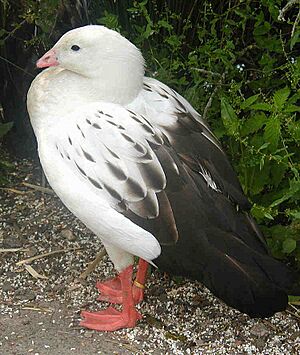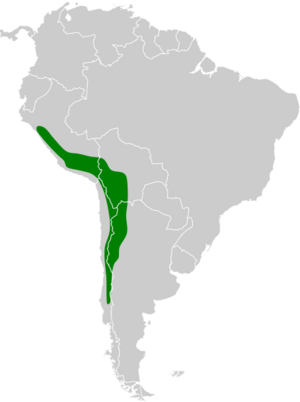Andean goose facts for kids
Quick facts for kids Andean goose |
|
|---|---|
 |
|
| Conservation status | |
| Scientific classification | |
| Genus: |
Chloephaga
|
| Species: |
melanoptera
|
 |
|
| Synonyms | |
|
Oressochen melanopterus |
|
The Andean goose (Chloephaga melanoptera) is a large type of waterfowl. It lives high up in the Andes mountains of South America. You can find it in countries like Argentina, Bolivia, Chile, and Peru. These geese are known for their bright white bodies and black wings. They spend most of their time on land, grazing on grasses.
Contents
About the Andean Goose
What Does It Look Like?
The Andean goose is a big bird. It can be about 70 to 76 centimeters (28 to 30 inches) long. It weighs between 2.7 and 3.6 kilograms (6 to 8 pounds). Both male and female geese look very similar.
Their heads and bodies are mostly white. Some feathers on their shoulders have dark centers, making them look striped. Their main wing feathers and tails are black and shiny. The goose has a bright coral red beak with a black tip. Its legs and feet are also light red.
Young geese are mostly white with some dark spots. As they get older, they look more like adults but their colors are not as bright.
Where Do They Live?
Andean geese live in the high mountains of South America. Their home stretches from Peru, through Bolivia, and into Chile and Argentina. They prefer open grasslands, wet areas called bogs, and the edges of lakes.
These geese almost always live above 3,000 meters (about 9,800 feet) in elevation. That's really high up! Sometimes, in Chile, they might move to lower areas if there's a lot of snow in winter.
How Do They Survive High Up?
Living at high altitudes means there is less oxygen in the air. Andean geese have a special trick to help them breathe easily. They have a unique change in their hemoglobin. Hemoglobin is what carries oxygen in their blood. This change helps their blood pick up oxygen much better than animals that live at lower elevations. It's like they have a built-in superpower for high places!
Andean Goose Behavior
Staying or Moving?
Andean geese usually stay in the same area all year round. They don't migrate long distances. They are mostly land birds, meaning they walk and graze. However, if they feel in danger, they will fly away. They also lead their young into the water to escape predators.
What Do They Eat?
Scientists don't know a lot about what Andean geese eat. But it seems they mostly eat different kinds of grasses. They often gather in loose groups, except when it's time to have babies.
How Do They Raise Their Young?
Andean geese become very protective of their space during breeding season. This season starts in November, which is springtime in the southern part of the world. They are thought to stay with the same partner for many years.
They don't build fancy nests. Instead, they lay their eggs in a shallow dip on the ground. This spot might be among a few plants or even on bare dirt. A female goose usually lays five to ten eggs. The male goose guards the female while she sits on the eggs. The eggs hatch after about 30 days.
What Sounds Do They Make?
Andean geese are quite noisy birds! Male and female geese make different sounds. Males might make a soft huit-wit-wit... or a low, grunting kwwwwwu.... They also have a single whistle they use to warn others. Females make louder, harsher sounds like a "kwa-kwak" or a "gack-gack."
Status of the Andean Goose
The IUCN (International Union for Conservation of Nature) says the Andean goose is a species of "Least Concern." This means they are not currently in danger of disappearing. They live in a very large area, and even though we don't know their exact numbers, their population seems stable.
Their remote mountain home helps protect them from people. It's unlikely that their habitat will change much soon. However, some farmers who raise sheep sometimes see these geese as competition for grazing land.



